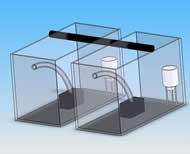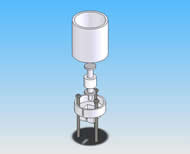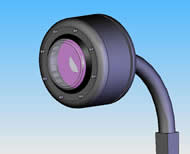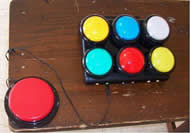Design of an Assistive Plant Watering System
Maura Nippert, John Brantley, Avinash Panga, Nathan Putnam, Austin Talley, Brandon Walther
Department of Mechanical Engineering, University of Texas at Austin, Austin, TX
ABSTRACT
A need was determined for a system to effectively assist the population of individuals with motor skill limitations in watering plants. Using a well defined customer based design methodology, a system was devised that accomplishes the watering function while providing positive feedback to the user and establishing a feeling of independence. The system consists of six permanently installed watering stations, differentiated from one another by six different light assemblies. Because it is centrally controlled, activated by a remote dashboard, and can interface with student switches, the system adapts to users of multiple ability levels. The system has received positive feedback from the customer and has been incorporated into regular student activities at Rosedale School.
KEYWORDS
Independence; planter; irrigation; school; switch;
BACKGROUND
Rosedale School is a member of the Austin Independent School District which helps students with special needs to improve their quality of life and increase participation in their community. One of the primary goals of this process is to cultivate a sense of independence and purpose. Rich Jones, a teacher at Rosedale and primary customer for the design project, was interested in using a plant watering activity to encourage his students to accomplish goals independently and outside of the familiar classroom environment.
Few assisted plant watering devices are currently available. All plant watering devices found on the market and in patent literature require the individual to aim, lift a water storage container or trigger arm, and in some cases use fine motor skills to squeeze a trigger or otherwise open a nozzle. In order to accomplish autonomous watering by the majority of Rosedale students, another option was necessary to eliminate these physical demands.
PROBLEM DEFINITION
Very early in the design process, customer interviews indicated that the design should not only water plants effectively, but should communicate a positive feeling to the user in the sense of reinforced success on the first try. The student needed be able to operate the device as independently as possible. The device was required to be accessible to the range of ability levels of the school by being compatible with all wheel chair designs, interfaceable with students’ personal switches, easy to use, and comprehensible on multiple cognitive levels. Finally, it was necessary that the device be durable, easy to store, and maintainable with as few steps as possible.
DESIGN METHODOLOGY
A design methodology defined by Otto and Wood [1] was followed to reach the final product. Decisions were weighted heavily on customer needs determined by extensive customer interviews, semantic inquiries, and demonstrations. Incorporation of these needs was initiated by creation of functional models to outline the functions required of the device, and activity diagrams to identify operations performed by the user. The concept generation phase was conducted using mind mapping and “6-3-5” brainstorming techniques. Professionals of diverse fields were included in the concept generation process to gain varied ideas for solutions. Concepts were selected using Pugh Chart comparison and follow-up customer interviews. Chosen designs were measured by Proof of Concept embodiments. An alpha prototype was built to identify problems with the selected design. Finally, a beta prototype was constructed and installed for customer use.
DESIGN EMBODIMENT
The final embodied design is a permanently installed system in an existing 39 ft planter at Rosedale School. The planter was divided into six independent stations, approximately 6 ft in length, each represented by a different colored light assembly as shown in Figure 1. A diagram of the system is available in Figure 2.
Each station consists of a 5 gallon water tank fitted with a submersible pump as shown in Figure 3. When the pump is turned on, water is sprayed into the air through nozzles that extend the length of the station. A floater switch assembly (Figure 4) installed in each tank prevents operation of a station when all of the water has been used. This protects the submersible pump from damage by dry operation.
A ring of appropriately colored LEDs surrounding each light assembly (Figure 5) indicates to the user that water is available in the tank. When the tank is dry, the light assembly is also disabled, showing the user that the plants in that station have been given sufficient water for that watering session.
Watering of the stations is remotely activated by a lightweight portable dashboard shown in Figure 6. Each individually operable colored button on the dashboard corresponds to the appropriate colored station. Because many students at Rosedale use their own switch for operation of assistive devices, the dashboard has six jacks for interfacing with student switches. At the press of a button, a microcontroller in the dashboard determines that the corresponding plant station is watered for five seconds. The electronics controlling this operation are shown in Figure 7.
OPERATING PROCEDURE
Rosedale School’s custodial staff is responsible for filling the water tanks twice a week to allow for two watering sessions per week. Each watering session is arranged by the teacher, who turns on the master switch at the control box and turns the dashboard key to the on position. The dashboard can then be given to a student or group of students for independent control of the system.
Initially, the LEDs are lit to indicate that all stations need to be watered. A student chooses which station he would like to water and then presses the appropriately colored button on the dashboard (or his own switch plugged into the appropriate jack). The system responds to the student’s choice by lighting the button on the dashboard and the corresponding light at the station. At the same time, the pump is activated and water visibly sprays in a crisscross fashion throughout the station. This procedure can continue for each station until the tank has been drained. At this point, the LEDs turn off and the system is disabled. The teacher must turn of both the master switch and the dashboard at the end of each watering session.
DESIGN EVALUATION
The ultimate evaluation of this product was students’ happy reactions to using it. Increased eagerness was seen with repeated use. The device is used as a game to be played between faculty and students, as a learning activity, and as an enjoyable task for a student to complete outside of the classroom. Observers witness a kind of conversation between students and the device, as students input signals and react positively to sensory feedback.
The final design satisfies all of the characteristics and customer needs outlined in the problem statement. The system is adaptable for multiple ability levels in that it can interface with up to six student switches and is compatible with all wheel chair designs. It is easy to use and can be used by students independently. The only steps requiring teacher assistance are to switch the power on, and to plug the student’s switch into the appropriate jack, if necessary.
CONCLUSION
The successful design of the assistive plant watering system has been proven by its implementation in Rosedale School activities. Because the system is suitable for many levels of physical ability, its use could also be extended to several secondary markets. For instance, the elderly could use it to continue garden maintenance when the physical requirements of conventional watering are too challenging. Other people with limited mobility would find the system helpful as well. It could even be used to reduce the steps of watering required for able bodied gardeners. Because the central control box uses relays to control several operations simultaneously, other devices such as sound, animated objects, or lighting systems could be used to increase sensory feedback. In these ways the system addresses a large consumer need from assisted technology that has not been previously satisfied.
ACKNOWLEDGEMENTS
A big thanks is owed to Rich Jones and the staff and students of Room 17 for making this project possible and for their tireless response to visits and inquiries. The authors would also like to thank Julie Miller and Kate May of Rosedale School Assistive Technology Department, and Sherri Rhein, Judy McGookey, and Signe Santoro of the Occupational Therapy Department for their poignant advice on appropriate assistive design. Dr. Kristin Wood and Dr. Rich Crawford created the opportunity to work with the students at Rosedale, provided exceptional guidance, and challenged the authors to challenge themselves.
REFERENCES
1. K.N. Otto, K.L. Wood, Product Design, Prentice Hall, Inc., NJ, 2001.
Author Contact Information:
Maura Nippert
c/o Dr. Rich Crawford
Department of Mechanical Engineering
University of Texas at Austin
1 University Station C2200
Austin, TX 78712-0292
(903) 271-3198
maura.nippert@gmail.com
Highlights
- Source Ordered
- No Tables
- Very Compatible
Gargoyles
Disney produced a television show in the mid 1990s called Gargoyles. It's a great show and I'm a big fan. A few years ago Disney started to release the show on DVD. The last release was of season 2, volume 1. That was two years ago. Volume 2 has not been released. Why? Poor sales. So if you should find yourself wanting to support my work, instead I ask you pick up a copy of season 2, volume 1. It's a great show and you might find yourself enjoying it.






